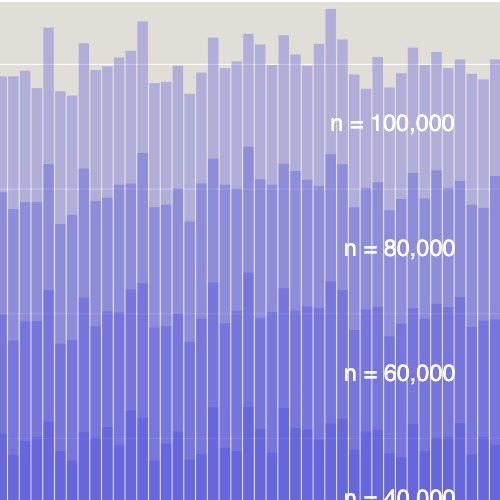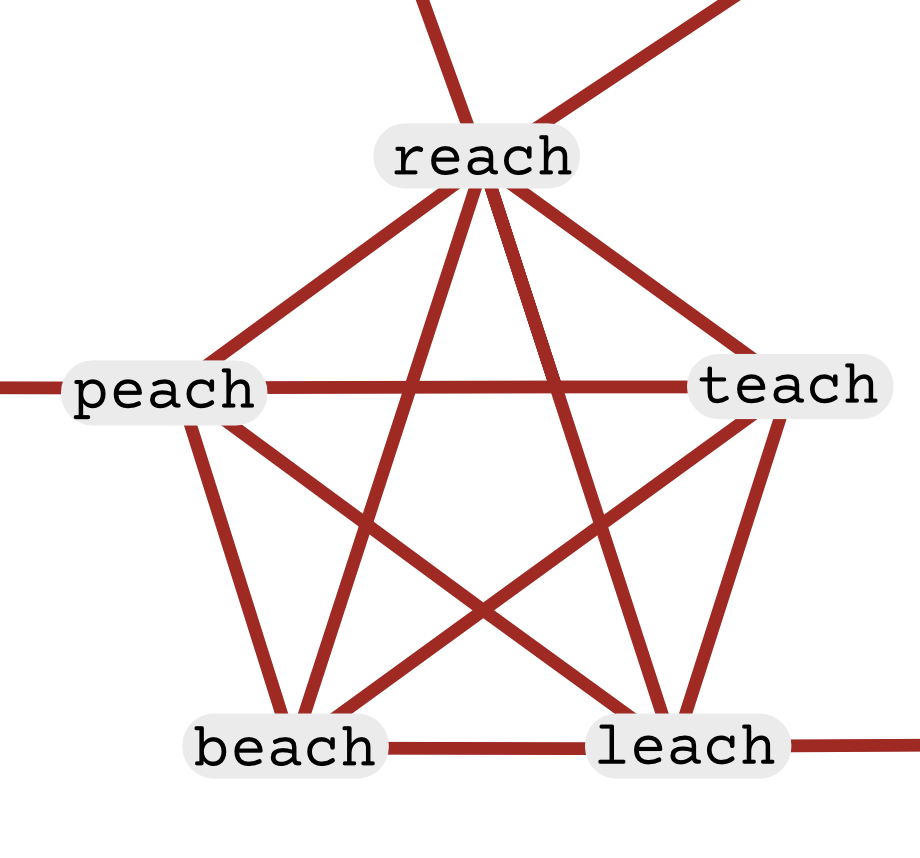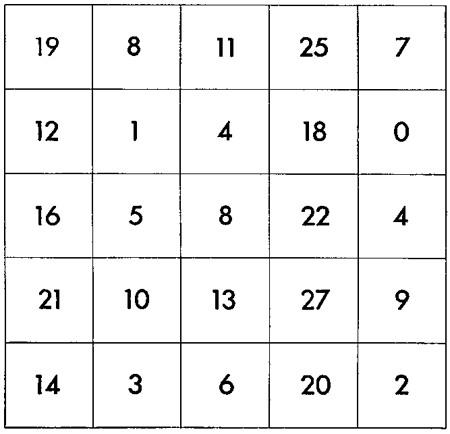A Mathematical Fable Previsited
by Brian Hayes
Published 1 May 2007
A year ago, in my American Scientist column, I was deconstructing the oft-told tale of Carl Friedrich Gauss and his boyhood triumph over a despotic schoolmaster. As the story goes, Gauss applied a bit of mathematical ingenuity to quickly solve a problem that the teacher had thought would keep the class busy for quite some time. I collected a hundred-and-some versions of this anecdote and tried to learn something about where the story came from in the first place and how it had evolved over a century and a half of telling and retelling. I remain on the lookout for new versions of the Gauss story, and I’m even more eager to find old versions. Lately I’ve had some success on both fronts.
First, here is the latest retelling I’ve come across. It can serve as a refresher for readers who may have forgotten some of the details. The passage comes from Ian Stewart’s new book, Why Beauty Is Truth: A History of Symmetry (Basic Books):
Gauss showed his talents early. At the age of three, he was watching his father, at that point a foreman in charge of a gang of laborers, handing out the weekly wages. Noticing a mistake in the arithmetic, the boy pointed it out to the amazed Gebhard. No one had taught the child numbers. He had taught himself.
A few years later, a schoolmaster named J. G. Büttner set Gauss’s class a task that was intended to occupy them for a good few hours, giving the teacher a well-earned rest. We don’t know the exact question, but it was something very similar to this: add up all the numbers from 1 to 100. Most likely, the numbers were not as nice as that, but there was a hidden pattern to them: they formed an arithmetic progression, meaning that the difference between any two consecutive numbers was always the same. There is a simple but not particularly obvious trick for adding the numbers in an arithmetic progression, but the class had not been taught it, so they had to laboriously add the numbers one at a time.
At least, that’s what Büttner expected. He instructed his pupils that as soon as they had finished the assignment, they should place their slate, with the answer, on his desk. While his fellow students sat scribbling things like
1+2 = 33+3 = 66+4 = 10with the inevitable mistake
10+5 = 14and running out of space to write in, Gauss thought for a moment, chalked one number on his slate, walked up to the teacher, and slapped the slate face down on the desk.
“There it lies,” he said, went back to his desk, and sat down.
At the end of the lesson, when the teacher collected all the slates, precisely one had the correct answer: Gauss’s.
Again, we don’t know exactly how Gauss’s mind worked, but we can come up with a plausible reconstruction. In all likelihood, Gauss had already thought about sums of that kind and had spotted a useful trick. (If not, he was entirely capable of inventing one on the spot.) An easy way to find the answer is to group the numbers in pairs: 1 and 100, 2 and 99, 3 and 98, and so on, all the way to 50 and 51. Every number from 1 to 100 occurs exactly once in some pair, so the sum of all those numbers is the sum of all the pairs. But each pair adds up to 101. And there are 50 pairs. So the total is 50 × 101 = 5050. This (or some equivalent) is what he chalked on his slate.
Stewart’s account includes most of the features that are now standard in tellings of this tale: the “busywork” assignment of summing the series 1+2+3+…+100, the trick of grouping the numbers in pairs, the ritual of piling up the slates on a table, and young Gauss’s bold declaration “There it lies.” As far as I know, all versions of the story derive ultimately from a single textual source, a memorial essay published in 1856 (a year after Gauss’s death) by Wolfgang Sartorius, Baron von Waltershausen, a colleague and friend of Gauss in his later years. But some of the most familiar elements of the modern narrative are missing from that first document. In particular, Sartorius never mentions the numbers 1 through 100, or any other specific series, and he gives no hint of how Gauss solved the problem. These details (and many others) have been filled in by later writers. (Ian Stewart, I would note, is careful to indicate that some parts of the story are conjectural; other authors are not so scrupulous.)
When I began looking into the history of this bit of mathematical lore, I was especially curious about the origin of the 1-to-100 example, and of the “pairing” method of explaining the summation shortcut. In the literature I surveyed last year, both of these ideas make their earliest appearance in a 1938 book by Ludwig Bieberbach, Carl Friedrich Gauß: Ein Deutsches Gelehrtenleben. But there were a few earlier works I had not been able to consult, and so I couldn’t be sure that Bieberbach was really the primary source. I’ve now tracked down two of those earlier tellings of the story. I won’t prolong your suspense: It turns out Bieberbach was not the first to mention 1+2+3+…+100. I have discovered an earlier appearance.
At the Brown University library I found a copy of a biographical sketch by Friedrich August Theodor Winnecke, Gauss: Ein Umriss seines Lebens und Wirkens. This was published in 1877, on the occasion of the 100th anniversary of Gauss’s birth. The passage dealing with the Büttner incident (German text here) closely follows Sartorius (who is acknowledged as the source). I note only one significant departure. Where Sartorius describes the assignment merely as “the summation of an arithmetic series,” Winnecke elaborates:
. . . die Summation einer arithmetischen Reihe, für deren Ausführung die Arithmetik eine sehr einfache, rasch zum Ziel führende Weise lehrt.
If I understand this correctly—and I would welcome help with translation—it means something like, “. . . the summation of an arithmetic series, for whose implementation arithmetic offers a very simple and quick means of reaching the goal.” Evidently Winnecke wanted to make clear that the shortcut was already well known—if not to schoolchildren then at least to their teachers. Sartorius says nothing one way or the other on this issue; later writers are sharply divided about whether or not Büttner already knew the method or learned it from his young pupil.
The second text that I have belatedly located is a pamphlet, Karl Friedrich Gauss, von Franz Mathé, published in 1906 as part of a series of portraits of masters in various fields. I found a copy, sadly rather tattered, at the New York Public Library. The German text of Mathé’s version of the schoolroom anecdote is here. What follows is my tentative attempt at a translation of the crucial passage. (Again, corrections and improvements are welcome.)
The reputable schoolmaster Büttner, who taught the arithmetic class, once gave the assignment of writing down and adding all the numbers in sequence from 100 down to 1. The problem had hardly been stated when young Gauss wrote the answer on his slate, put it on the table, and declared in his Braunschweig dialect, “There it lies.” The teacher, whip in hand, cast sardonic and pitying glances at the little smart-aleck who dared claim he had a solution that the rest of the class was still bitterly sweating to produce. However, the examination of the slates revealed that young Gauss alone had supplied the correct result. Furthermore, he was able to show the teacher how he had arrived at the solution. He explained: 100 plus 1 is 101; 99 plus 2 is 101; likewise 98 plus 3 is 101, and so on. Thus one gets as many times 101 as there are “pairs” formed from one hundred numbers. The result is therefore 50 × 101, or 5,050.
Clearly, we have a new precedent for the 1-to-100 series. Was Mathé the source from whom Bieberbach and so many later writers (all the way down to Ian Stewart today) obtained this example? Possibly, but the textual evidence is not compelling. The only phrases in Bieberbach that closely resemble Mathé’s words are passages that they both borrowed from Sartorius. And note that Mathé describes the series somewhat curiously as “100 down to 1” (“alle Zahlen der Reihe nach von 100 herab bis zur 1”), whereas Bieberbach, like all later authors, counts up from 1 to 100 (“die Zahlen von eins bis hundert”). Also, whereas Mathé has young Gauss showing his teacher the trick for summing an arithmetic progression, Bieberbach states clearly that Büttner already knew the method. We can’t rule out the possibility that Bieberbach had Mathé’s essay in front of him, but there are no signs of cribbing, apart from the numerical coincidence. And both authors might have invented the 1-to-100 example independently or under the influence of older sources.
Further light on such older sources has come to me in a letter from Don Knuth. I had mentioned that the “pairing” algorithm for summing a series can be traced back to an eighth-century manuscript titled “Propositiones ad acuendos juvenes,” or “Problems to Sharpen the Young,” where the example given is our old familiar series 1-to-100. Knuth points out that the pairing idea appears another millennium earlier in the works of Archimedes. And this time there might well be evidence of influence, or borrowing, or some form of the direct transmission of ideas.
The “Propositiones ad acuendos juvenes” are usually attributed to a monk known as Alcuin of York, who was associated with the court of Charlemagne around the year 800. (The Latin manuscript is available online here. An English translation by Peter J. Burkholder was published in 1993 in HOST: An Electronic Bulletin for the History and Philosophy of Science and Technology, which was then distributed as an e-mail list. The mailing list archives are available on the Web, though in an oddly garish context.) Here is Burkholder’s translation of the Alcuin story, which takes the form of a problem and solution.
There is a ladder which has 100 steps. One dove sat on the first step, two doves on the second, three on the third, four on the fourth, five on the fifth, and so on up to the hundredth step. Let him say, he who can, How many doves were there in all?
Solution. There will be as many as follows: Take the dove sitting on the first step and add to it the 99 doves sitting on the 99th step, thus getting 100. Do the same with the second and 98th steps and you shall likewise get 100. By combining all the steps in this order, that is, one of the higher steps with one of the lower, you shall always get 100. The 50th step, however, is alone and without a match; likewise, the 100th stair is alone. Add them all and you will find 5050 doves.
When I first read Alcuin’s solution, the asymmetry of the process struck me as very strange. Why would anyone choose to pair the first element of the series with the next-to-the-last element, leaving the final element on its own? The result seemed needlessly complicated. Instead of the simple formula 50 × 101—familiar from so many tellings of the Gauss tale—we have (49 × 100) + 50 + 100. Did Alcuin favor this convoluted method just because it allowed him to deal with even hundreds rather than multiples of 101? That was my first thought, but now I wonder if there might not be a historical explanation—an instance of the powerful influence of an example from antiquity.
Archimedes’ treatment of the summation problem appears in Proposition 11 of On Spirals, but in Thomas Heath’s edition it is given as a bracketed interpolation in another treatise, On Conoids and Spheroids. Here is how Heath presents the argument:

Note the interesting grouping of terms in the third equation: A1 + An–1 = A2 + An–2 = . . . = An. There’s at least a hint here of the pairing process found in Alcuin’s solution. The resemblance is not actually all that deep, as can be seen by working through a small example, such as n = 10. Alcuin would form the sum S = (1+9) + (2+8) + (3+7) + (4+6) + 5 + 10, whereas the calculation of Archimedes (or Heath) is 2S = (1+9) + (2+8) + (3+7) + (4+6) + (5+5) + (6+4) + (7+3) + (8+2) + (9+1) + 10 + 10. Still, in spite of this underlying conceptual difference, I can imagine that whoever wrote the youth-sharpening solution to the 100-rung ladder problem was inspired by a glance at the work of Archimedes. And it’s not too much of a stretch to suppose that an educated monk in the court of Charlemagne might have some aquaintance with Archimedes. (On the other hand, David Singmaster suggests that the origin of the 100-doves problem is Chinese.)
(Another reason for caution in constructing supposed chains of transmission: a Web posting by Said Boutiche, dated 2005, also represents 1+2+3+…+100 as (49 × 100) + 50 + 100, and yet there is no evidence at all of influence from Archimedes or Alcuin.)
Whatever the ultimate source of the summation anecdote, I find it fascinating that we are still telling ourselves this little story, over and over, across decades and centuries and perhaps millennia. It has become a cultural artifact, like a fairy tale or a nursery rhyme, but attached specifically to mathematical culture. We learn it early on from a teacher or a book, and later we pass it on to the next generation, perhaps with alterations or embellishments that adapt it to the needs and tastes of our own time.
For more on the Gauss anecdote and related subjects, please see:
- my American Scientist column from May–June 2006
- an earlier bit-player posting, focusing on the question of how the rest of the kids in Gauss’s class might have approached the problem
- the complete collection of tellings and retellings
- a full bibliography
- a chronological table summarizing all versions of the story known to me
- essays by Ivars Peterson on the Gauss anecdote and on “Propositiones ad acuendos juvenes”
Finally, I have a couple of questions that I would like to throw out to anyone else who has time to waste on these trivial pursuits:
First, who was Franz Mathé? The 1906 pamphlet tells us nothing about the author, and I have failed to find anything about him elsewhere. He’s not listed in the Mathematical Genealogy Project.
Second, I know of one other early biographical work on Gauss that might plausibly include a version of the schoolroom anecdote. Here is the reference: Wittstein, Theodor. 1877. Gedachtnissrede auf Carl Friedrich Gauss. Hannover: Hahn. If anyone has access to a copy of this (the Harvard catalogue says there’s one in the Widener Depository) and would like to check for a Büttner story, I would be delighted to receive the information and post it here.
Update 2007-05-05: Barry Cipra has found and helpfully transcribed three more tellings of the story:
- A 1937 essay by G. Waldo Dunnungton. With this addition we now have four published accounts of Gauss’s childhood written by Dunnington, spanning more than 30 years. In two of those versions he says nothing about the incident in Büttner’s schoolroom. In his 1955 biography, he tells the standard story, including the 1-to-100 example and the pairing method. In the 1937 version, the assignment is just “a long, difficult exercise in calculation,” in which Gauss “noticed the law of the arithmetical series.”
- A 1997 book by J. Munro, Heroes of the Telegraph (full text available online). This one has a unique twist: The assignment was intended only for the older pupils, and young Gauss asked to be included.
- Stephen W. Hawking‘s 2005 book, God Created the Integers: The Mathematical Breakthroughs that Changed History. Hawking is one of those who offer an alternative to the “busywork” hypothesis. In his rendition, the assignment was made “when the class began to be unruly.”
Thanks, Barry.
Update 2008-08-05: I still don’t know anything about Franz Mathé, but the memoir by Theodor Wittstein is no longer a loose end. I got ahold of it last October, through the kindness of Sally Bosken of the U.S. Naval Observatory library, but neglected to post an update here. Wittstein does not mention the Büttner story, or anything else about Gauss’s childhood.
Responses from readers:
Please note: The bit-player website is no longer equipped to accept and publish comments from readers, but the author is still eager to hear from you. Send comments, criticism, compliments, or corrections to brian@bit-player.org.
Publication history
First publication: 1 May 2007
Converted to Eleventy framework: 22 April 2025




I’m curious that this surprised you:
“a Web posting by Said Boutiche, dated 2005, also represents 1+2+3+ … +100 as (49 * 100) + 50 + 100, and yet there is no evidence at all of influence from Archimedes or Alcuin.)”
I find this approach very natural despite the lack of symmetry… the lure of the
perfect totals of 100… and I am not alone:
I have this problem to a smart 12 year old in my daughter’s class as we hiked
in the Panama rainforest in March, and he had it within minutes, no paper in
sight. At first he didn’t realize that he’d overlooked 50 and 100, but he found
that method much easier to grasp than pairing numbers to add to 101, which
I explained to him later.
In mathematics, “elegance” is often associated with the concept of “simplest way” to find a solution for a problem. To illustrate the meaning of “simplest way” in mathematics, I reconsider here the above S calculation for n=10:
Let consider first the standard calculation:
S = 1+2+3+4+5+6+7+8+9+10
This “standard evaluation” of S, involves a number of 9 operations that is equal to the number of (+) symbols.
The calculation of S according to Archimedes (or Heath) starts with 2S = (1+9) + (2+8) + (3+7) + (4+6) + (5+5) + (6+4) + (7+3) + (8+2) + (9+1) + 10 + 10.
It involves 4 operations: (3 operations that find 2S= 9×10 +10+10) followed by the one that finds S (S=(10 x 9 +10+10)/2.).
While the Alcuin sum S = (1+9) + (2+8) + (3+7) + (4+6) + 5 + 10 = 4 x 10+5+10 involves only 3 operations.
A brief comparison of these 3 methods shows that the Alcuin method is certainly the most elegant since it involves only 3 operations.
One can ask however, why the number of operations becomes considerably reduced in the Archimedes and Alcuin methods? Both methods use a spatial redistribution of numbers that is “easily accessible” to our perception and sense of evaluation.
Said Boutiche writes:
“A brief comparison of these 3 methods shows that the Alcuin method is certainly the most elegant since it involves only 3 operations.”
Actually the Alcuim method involves a fourth, preliminary operation: 4 = int(9/2). This is perhaps more obvious if one asks for a more arbitrary sum, say 1+2+…+1776. Determining the number of pairs (1+1775), (2+1774), etc. clearly requires a nontrivial calculation, at least in our base 10 system — it would be an easy calculation if we wrote everything base 2!